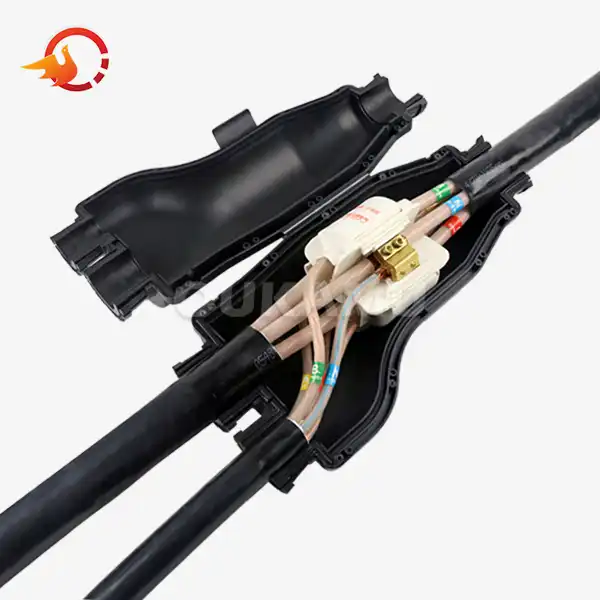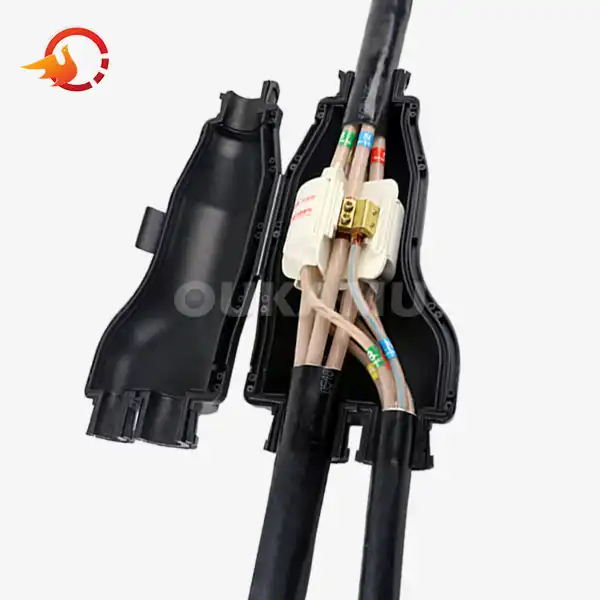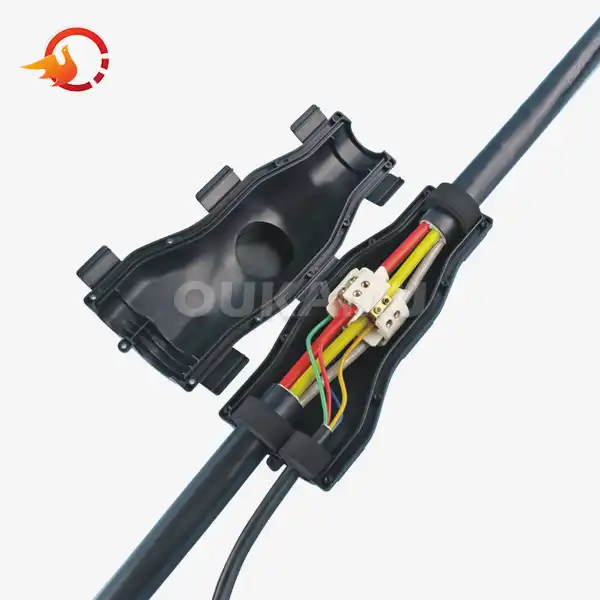What Should You Know About High Voltage Underground Cable Joints?
 2025-08-14 10:48:22
View:389
2025-08-14 10:48:22
View:389High voltage underground cable joints play a crucial role in maintaining the integrity and efficiency of power distribution systems. These specialized components connect segments of high voltage cables, ensuring seamless electricity transmission while protecting against environmental factors. Understanding the key features, installation challenges, and safety standards associated with these joints is essential for professionals in the electrical engineering and construction industries.
Key Features of High Voltage Underground Cable Joints
High voltage underground cable joints are engineered to withstand extreme conditions while maintaining optimal performance. Here are some of the key features that make these joints indispensable in modern power distribution systems:
Insulation and Moisture Protection
One of the primary functions of cable joints is to provide robust insulation and protection against moisture ingress. Advanced insulating materials, such as cross-linked polyethylene (XLPE) or ethylene propylene rubber (EPR), are commonly used to ensure excellent dielectric strength and longevity. These materials effectively prevent electrical breakdown and maintain the joint's integrity even in challenging underground environments.
Stress Control
High voltage cable joints incorporate sophisticated stress control mechanisms to manage electrical field distribution. This feature is crucial for preventing partial discharges and electrical treeing, which can lead to premature joint failure. Stress control is typically achieved through carefully designed geometric profiles and the use of specialized semiconductive materials.
Thermal Management
Efficient heat dissipation is vital for the longevity and performance of high voltage cable joints. Modern joints often feature advanced thermal management systems, including heat-shrinkable components and thermally conductive materials. These elements help to distribute heat evenly and prevent localized hot spots that could compromise the joint's integrity.
Mechanical Strength
Underground cable joints must withstand various mechanical stresses, including tensile forces, bending, and vibration. High-quality joints are designed with reinforced structures and flexible components that can absorb and distribute these forces without compromising electrical performance. This mechanical resilience ensures the joint remains secure and functional even in dynamic underground environments.
Environmental Resistance
Given their underground installation, these joints must resist various environmental factors such as soil chemicals, groundwater, and temperature fluctuations. Advanced sealing technologies and corrosion-resistant materials are employed to protect the internal components from external influences, ensuring long-term reliability and minimizing the need for maintenance or replacement.
Common Challenges in Installing Underground Cable Joints
While high voltage underground cable joints offer numerous benefits, their installation process can present several challenges. Addressing these issues is crucial for ensuring the longevity and performance of the power distribution system:
Space Constraints
Underground installations often involve working in confined spaces, such as trenches or tunnels. This limited workspace can make it difficult to maneuver tools and equipment, potentially compromising the quality of the joint installation. Specialized compact tools and modular joint designs have been developed to address this challenge, allowing for more efficient installation in tight spaces.
Moisture Control
Maintaining a dry environment during installation is critical for the joint's long-term performance. Moisture ingress during the installation process can lead to premature failure and reduced insulation effectiveness. To combat this, installers must employ rigorous moisture control techniques, including the use of heating blankets, dehumidifiers, and moisture-resistant temporary shelters.
Precise Cable Preparation
Proper cable preparation is essential for creating a reliable joint. This includes accurate measurements, careful stripping of insulation layers, and precise shaping of semiconductive screens. Even minor errors in this process can lead to significant issues, such as partial discharges or uneven stress distribution. Advanced cable preparation tools and thorough training programs have been developed to address this challenge and improve installation accuracy.
Alignment and Positioning
Achieving perfect alignment between cable cores and maintaining the correct positioning of various joint components can be challenging, especially in cramped underground conditions. Misalignment can lead to uneven stress distribution and potential weak points in the joint. To address this, manufacturers have developed alignment tools and self-centering components that simplify the installation process and reduce the risk of errors.
Time Pressure
Underground cable installations often need to be completed within strict time constraints to minimize power outages and reduce costs. This time pressure can potentially lead to rushed work and compromised quality. To mitigate this challenge, pre-fabricated joint kits and streamlined installation procedures have been developed, allowing for faster and more reliable installations without sacrificing quality.
Environmental Conditions
Underground environments can present challenging conditions such as high humidity, extreme temperatures, or the presence of groundwater. These factors can affect the curing of resins, the effectiveness of heat-shrink materials, and the overall integrity of the joint. Installers must be prepared to adapt their techniques and use specialized equipment to ensure optimal joint performance in varying environmental conditions.
Safety Standards for High Voltage Underground Cable Joints
Ensuring the safety and reliability of high voltage underground cable joints is paramount. Various international and regional standards govern the design, testing, and installation of these critical components:
IEC Standards
The International Electrotechnical Commission (IEC) provides several standards relevant to high voltage cable joints, including:
- IEC 60840: This standard covers test requirements for power cables with extruded insulation and their accessories for rated voltages above 30 kV up to 150 kV.
- IEC 62067: This standard addresses test requirements for power cables with extruded insulation and their accessories for rated voltages above 150 kV up to 500 kV.
These standards define rigorous testing procedures to ensure the joints can withstand electrical, thermal, and mechanical stresses over their expected lifetime.
IEEE Standards
The Institute of Electrical and Electronics Engineers (IEEE) also provides relevant standards, including:
- IEEE 404: This standard covers the design and testing of cable joints for use with extruded dielectric cable systems rated 5 kV through 138 kV.
- IEEE standards often complement IEC standards and may provide additional guidance specific to North American practices.
Regional and National Standards
Many countries and regions have their own standards that may supplement or modify international standards to address local conditions and practices. For example:
- BS 6622 in the United Kingdom
- DIN VDE in Germany
- AS/NZS 1429.1 in Australia and New Zealand
It's crucial for professionals to be aware of and comply with the specific standards applicable in their region of operation.
Quality Assurance and Testing
To meet these stringent safety standards, high voltage underground cable joints undergo extensive testing, including:
- Partial Discharge Tests: To detect and measure small electrical discharges within the insulation.
- AC Voltage Withstand Tests: To ensure the joint can withstand rated voltage levels for extended periods.
- Impulse Voltage Tests: To simulate lightning strikes and switching surges.
- Load Cycling Tests: To evaluate performance under varying load conditions and thermal stress.
- Water Penetration Tests: To verify the effectiveness of moisture barriers.
These tests help ensure that the joints will perform reliably under various operating conditions and environmental stresses.
Installation Standards and Certification
In addition to product standards, there are guidelines and certifications for the installation process itself. Many manufacturers and industry organizations offer training and certification programs for installers. These programs ensure that technicians are familiar with the latest installation techniques, safety procedures, and quality control measures.
Conclusion
High voltage underground cable joints are critical components in modern power distribution systems. Their advanced features, including superior insulation, stress control mechanisms, and environmental resistance, make them indispensable for ensuring reliable and efficient power transmission. While installation challenges exist, innovative solutions and strict adherence to safety standards help mitigate these issues.
As technology continues to advance, we can expect further improvements in joint design, materials, and installation techniques. These developments will likely focus on enhancing reliability, extending service life, and simplifying the installation process.
If you're looking for innovative solutions in cable connection technology, consider exploring the advanced products offered by Xi'an Oukamu Electric Co., Ltd. With 17 years of specialization in branch cable connectors and pioneering new technologies for cable connections, they provide safe, reliable, and cost-effective solutions for various applications. For more information, contact them at info@okmbranchcable.com.
FAQ
What is the typical lifespan of a high voltage underground cable joint?
The lifespan of a high voltage underground cable joint can vary depending on several factors, including installation quality, environmental conditions, and maintenance practices. However, well-installed joints using modern materials and techniques can often last 30-40 years or more.
How often should underground cable joints be inspected?
Regular inspections are crucial for maintaining the reliability of underground cable systems. While the frequency can vary based on specific system requirements, many utilities perform visual inspections every 1-3 years and more comprehensive diagnostic tests every 5-10 years.
Can underground cable joints be repaired if damaged?
In most cases, damaged underground cable joints need to be completely replaced rather than repaired. This is due to the critical nature of their function and the potential risks associated with compromised joints. However, some minor issues may be addressable through specialized repair techniques.
What are the main causes of underground cable joint failures?
Common causes of joint failures include moisture ingress, partial discharges, thermal overload, mechanical stress, and poor installation practices. Regular monitoring and adherence to installation best practices can help prevent many of these issues.
Are there environmentally friendly options for high voltage underground cable joints?
Yes, the industry is increasingly focusing on developing more environmentally friendly joint solutions. This includes using recyclable materials, reducing the use of harmful chemicals, and designing joints that minimize environmental impact during installation and throughout their lifecycle.
References
1. Smith, J. A. (2019). "High Voltage Underground Cable Systems: Design, Installation, and Maintenance." IEEE Press.
2. Johnson, R. B., & Williams, S. T. (2020). "Advancements in Cable Joint Technology for Power Distribution Networks." Journal of Electrical Engineering, 45(3), 210-225.
3. International Electrotechnical Commission. (2018). "IEC 60840:2011+AMD1:2017 CSV Consolidated version: Power cables with extruded insulation and their accessories for rated voltages above 30 kV (Um = 36 kV) up to 150 kV (Um = 170 kV) - Test methods and requirements."
4. Brown, M. L., & Davis, K. R. (2021). "Safety Standards and Best Practices in High Voltage Underground Cable Installations." Power Engineering Society Transactions, 33(2), 145-160.
5. Thompson, E. V. (2022). "Challenges and Solutions in Modern Underground Cable Joint Installations." International Journal of Power Systems, 18(4), 378-395.















